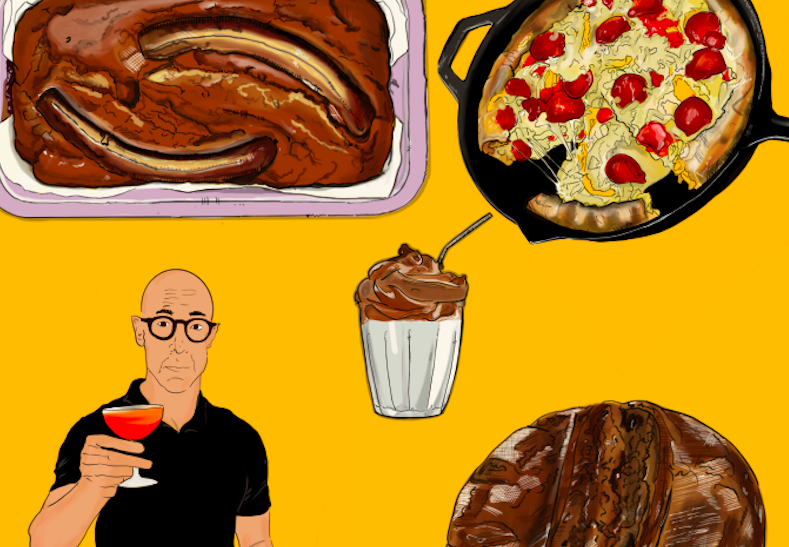
The onset of a national lockdown in mid-March meant that a great portion of the population had a lot more time on their hands. Craving comforts during an uncertain time, people, as they have for generations, turned to food. Here are some of the most popular trends that many of us mastered this year – and we hope they are here to stay.
Banana Bread
It all began with the bread that seems more like a cake, but is dubbed bread just to alleviate guilt after gluttonous indulgence. Times Record News recorded that from March to April this year there was an 83 per cent increase in banana bread searches on Google. A one bowl wonder, it’s popularity can be derived from the cathartic smashing of bananas, the smell of the caramelized fruit permeating through the house and the finding a purpose for the forgotten mouldering bananas lurking in the corner. Best eaten fresh from the oven, a slice – crumbly soft and delicious – allows thoughts to dwell over the raisin-to-bite ratio instead of the number of daily cases. A brief but sweet respite.
Dalgona Coffee
Dalgona coffee is the perfect accompaniment to cake. Having featured in a Korean TV clip shared on YouTube in January, social media was soon ablaze with images of the foamy frothy creation. While the origins of the concoction have been much disputed, there’s no doubting that the drink caused a social media frenzy. As a coffee-brewer-biscuit-dunker person myself, I was reluctant to deviate from my morning staples, but was lulled in by Dalgona coffee’s apparent simplicity and quick preparation time. Two teaspoons of coffee, one sugar and whip until it looks like the top of a perfect 99. Then, you simply pour it over milk and voila – Instagram food accounts delight. I initially stared in awe as it hovered in a cloudlike vision of glory, before giving a defeated sigh as the coffee concoction sunk into the pits of hot milk. Using a fork rather than a whisk may have been a factor in my downfall but needs must in the pursuit of culture fads.
Sourdough Bread
Another accompaniment to coffee is, of course, the ever-popular sourdough. I can confirm that people who manage to make sourdough in times of normality are extremely impressive – free from routine or social obligation, the task, for me, proved time-consuming, arduous and futile. Many have linked the rise in sourdough baking with another trend that arose during lockdown: “cottagecore”. This newfangled craze centers around the aesthetics and ideas of a simple life and a return to traditional skills and crafts. Think: baking, green thumbs, home-cooking and weaving – essentially a Taylor Swift legion. Debate its rise in popularity if you will, but there’s no doubting that once you have had one slice of fresh sourdough, slathered in butter and marmalade, the whole loaf can quickly come under attack.
Cocktails
In returning to drinks, many of the stereotypes linked with Irish people center around both alcohol and tea. In 1941 during World War Two, Britain imposed restrictions on tea exports to Ireland, in an effort to sway their neutral status, thus attacking the very bed-rock of the Irish persona. This resulted in military uprising, workers strikes and the watering down of turf mould in an attempt to replicate the delicacy they so keenly missed. In 2020, the government restrictions necessitated the closure of all pubs, and all over the country people wept tears of salt and Guinness as another standing stone of Irish society trembled. Instead of taking to the bogs, people turned to cocktails. Deceivingly easy, it seems at first that all one needs for a home bar are spirits and paper umbrellas. However, having been served Piña Colada with a bowl of sugar in an effort to balance the rum, and a Bloody Mary accompanied by a glass of milk to soothe the throat after miscalculations with chilli – I think I’d rather hedge my bets on the turf tea.
Pan–Pizza
This fifth and final trend consolidates the fact that carbohydrates make the ultimate comfort foods. Without restaurants to go to, and for country-dwellers existing beyond the realms of Deliveroo, there came the rise of the “fakeaway” and eventually, the Pan–Pizza. Cynical at first, I couldn’t understand the rationale behind leaving the tried and tested oven-bake in the past but, in this case, my assumptions were proved wrong. Lightly frying the dough ensured a crisp crust without risk of burning, and slinging the toppings on in a rapid succession of sauce, scamorza, sautéed onions and chorizo meant that the cheese oozed over the side and sunk into the crust edges with a satisfying sizzle. If convenience is the way of the future, then consider me converted.






